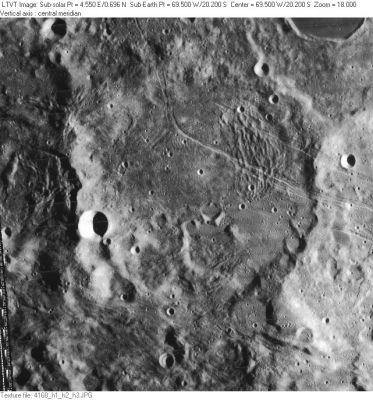Darwin
Contents
Darwin
(IAU outline modified in 1964)
|
Lat: 19.82°S, Long: 69.16°W, Diam: 122.18 km, Depth: 1.36 km, Rükl 50 |
LO-IV-168H Darwin is the large crater in the center with a portion of Rimae Darwin passing over it. The northern part of Lamarck is visible at the bottom.
Images
LPOD Photo Gallery Lunar Orbiter Images Apollo Images
South of Darwin is a Concentric Crater noticeable, which was not included in C.A.Wood's list of 1978. The pinpoint coordinates of this Concentric Crater are: 23° South/ 69°30' West. Further investigation reveals the IAU's designation of this Concentric Crater: Lamarck B. See the Hi-Res scan of Lunar Orbiter 4's photograph LOIV-168-h1.
Research: Danny Caes
Maps
(LAC zone 92A4) LAC map Geologic map
Description
Wikipedia
Additional Information
- IAU page: Darwin
- Depth data from Kurt Fisher database
- Westfall, 2000: 1.36 km
- Cherrington, 1969: 3.07 km
- The bowl-shaped high-albedo crater on the west-southwestern part of Darwin's rim shows an oblique impact craterlet on the southeastern part of its inner slopes (of the high-albedo crater). On the LRO's medium close-up photographs, the sunlit inner slopes of this bowl-shaped crater are over-exposed and show a cluster of black pixels (probably because of the intense high-albedo value of the small oblique impact craterlet). Additional research: Danny Caes
- A location at or near Darwin seems to be the centre of a basin which is unofficially known as U2, according to the nearside and west maps in the page Lunar Basins List.
- Darwin C contains an oblique raycrater on the southeastern part of its inner slopes. - DannyCaes Aug 23, 2014
Nomenclature
- Named for Charles Darwin (February 12, 1809 – April 19, 1882). Darwin was already eminent as an English naturalist when he proposed and provided scientific evidence to show that all species of life have evolved over time from one or a few common ancestors through the process of natural selection. The fact that evolution occurs became accepted by the scientific community and the general public in his lifetime, while his theory of natural selection came to be widely seen as the primary explanation of the process of evolution in the 1930s, and now forms the basis of modern evolutionary theory. In modified form, Darwin's scientific discovery remains the foundation of biology, as it provides a unifying logical explanation for the diversity of life.
- The name was proposed by Julius Schmidt on page 265 of his 1878 book. Schmidt does not explain which Darwin he intended to honor. Charles' son George would later become a prominent lunar theorist, but he is unlikely to have been known to Schmidt in 1878.
- Prior to 1964, Darwin included the area now known as Lamarck. The outline was changed in IAU Transactions XIIB.
LROC Articles
- Slumping Rim of Darwin C
- Perched Crater (the high-albedo craterlet on the rim of Darwin C).
LPOD Articles
Bibliography
Hill, Harold. 1991. A Portfolio of Lunar Drawings, pages 146, 147.
Named Features -- Prev: D'Arsonval -- Next: Rimae Darwin
